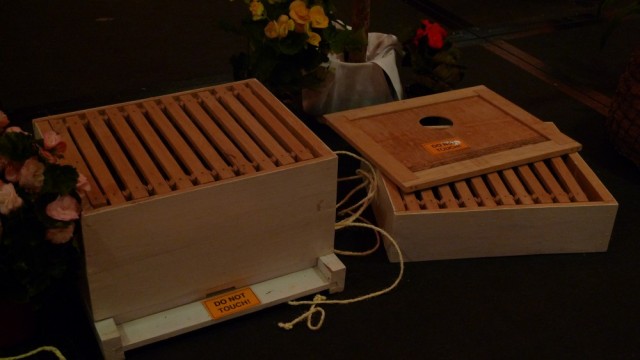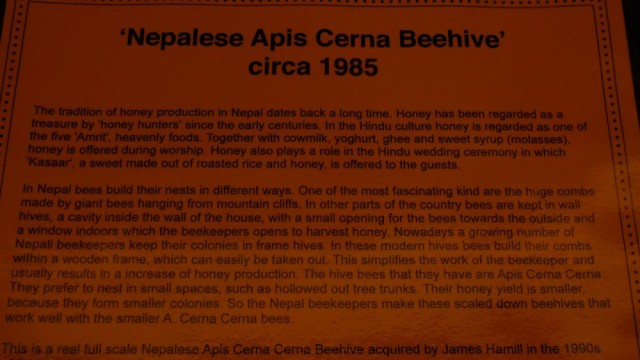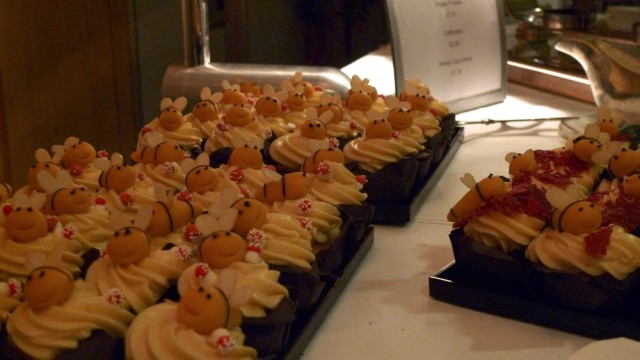I’ve come down with a cold, so am writing this in a feverish sleepless state. So apologies if any of it does make sense – or indeed doesn’t make sense! Feeling a bit sniffly, yesterday I headed down to the third ever London Honey Show, run by the London Lancaster hotel.
It had been moved to a bigger room this year (compared to 2011, I missed the 2012 show), down in the basement with no windows. It was good to have the space but I missed natural light, which tends to make honey glow more. Some free mead and beer samples were on offer, which helped my sore throat a little.
Some unusual hives were on display…
Apis Cerana Cerana prefer small hives.
The first speaker, the delightfully named Michael Badger MBE, was speaking on ‘Urban beekeeping in a bee house’. Given that his bee house (located in his garden outside Leeds) looked bigger than the average London garden, I doubt many of us will be able to replicate it, but it did look rather good.
Unfortunately his presentation was beset by technical difficulties and he seemed to have lost a lot of photos which should have been on his usb stick. This made it quite stop-and-start, as various members of the hotel’s IT team had to jump up and help him. He was unaware of how to rotate pictures, so we had to look at a few by tilting our heads 90 degrees until help arrived!
What is a bee house? Mr Badger has designed a large shed with several hives kept inside. Gaps at the top of the shed allow the bees to fly out; air being allowed to circulate in all the time prevents the problem of the bees thinking it’s warmer outside than it really is. It’s a more complex and clever design than that, but not being a practical person I’m afraid I can’t recall the finer details. He emphasised the importance of keeping the bee house clean, not dropping any wax or honey on the floor, and indeed it did look most spick and span.
I was encouraged that he mostly keeps his bees on a brood-and-a-half or double-brood system, as we are overwintering some of our hives on double brood boxes this year. For ease of lifting, some of his colonies are even kept completely in supers! I have not seen anyone do this before.
“Beekeepers never seem to know anything about bees” he told us, and recommended we read up about bees (not just beekeeping). As farmers know their livestock, so we should know our bees – their communication systems and biology. The books he finds most useful are Dr Colin Butler’s ‘World of the honeybee‘ – out of print, but available through public libraries – and the more recent Ted Hooper, ‘Guide to Bees and Honey‘ and Mark L. Winston’s ‘The Biology of the Honeybee‘.
In April 2014 Mr Badger has a book coming out, ‘Heather Honey – its production and uses’. It has chapters on heather honey ecology, production and its uses – mead, wax, honey cakes, medicinal – and will be published by Bee Craft Ltd.
In my next post I’ll write up my notes from Dale Gibson’s presentation, ‘A year in the life of the Bermondsey Street Bees’ and show you some more photos from the evening. I’ll leave you with some sweet bee cupcakes.




Does Mr Badger’s bee house keep the bees warmer in the winter, I mean when the temperatures really fall?
LikeLike
I expect so, as it will act as a wind shield and another layer of insulation. This would mean they get through more honey however, as more warmth would encourage them to have a bigger brood nest than usual, so he must have to ensure they’ve got plenty of stores.
LikeLike
Should it read– Nepalese Apis Cerana beehive– which is the Asian bee from which the parasite Varroa crossed to Apis Mellifera and caused so much havoc? Varroa does not destroy its original host Cerana but is merely a parasite.
LikeLike
I wondered that. ‘Cerna’ is repeated several times on the information so I assumed it must be right, but looking online Cerana does seem to be the correct spelling. Apis Cerana swarms more often than Apis Mellifera, which I think is one of the reasons varroa has less effect on them.
LikeLike
Yes,Apis cerana has a shorter egg-to-bee time and so outbreeds the mite as the colony builds up.
Apis Mellifera is slower and the mite often outbreeds the bee. Where the two races of bee interface in eastern Russia, Apis Mellifera has over the centuries developed some resistance to Varroa and some American beekeepers have imported Russian bees with some success.
LikeLike
In college, a cold was an excuse to drink a hot toddy. If I remember correctly, you mixed whiskey in hot water, squeezed in some lemon juice, and added a spoonful of honey. You better take care of that cold! 🙂
LikeLike
Nice! I have been having honey but only in tea so far!
LikeLike
Careful with the hot water, above 50 degrees kills the enzymes in fresh honey. But I agree- Fresh honey in warm water Whisky and fresh squeezed Lemon almost makes it worthwhile having a cold!
LikeLike
Hope you feel better soon. A friend of mine recently gave me a recipe for a honey based / foraged cure all… you collect a pound of elderberries, mush them up, add a pound of honey, leave it to steep for a few days, then strain through a sieve and keep in the fridge. It will keep for ages. I add it like squash to hot water (and a bit of whiskey if I am feeling really sorry for myself!).
LikeLike
Thanks Dave, what an intriguing recipe. I have some redcurrants, wonder if they would do instead. That’s two votes for whiskey!
LikeLike
Honey and a whole lemon in hot water was the secret weapon that slew the common cold I had last week. I wish you a rapid recovery.
LikeLike
Thanks Alex. I had some honey yesterday and am feeling better today.
LikeLike
Pingback: Cough And Sore Throat Soothing Honey Lollipops | Romancing the Bee
Hope you feel better soon and I will be sharing this and part 2 over on the College of the Melissae and More Bees less assholes pages on Facebook. Thank you for the awesome write ups 🙂
LikeLike
Wow, thanks Raven! Love the name of the ‘More Bees less assholes’ page.
LikeLike
You’re welcome and the part 1 post will be coming out on the hour and the part 2 an hour later on both pages 🙂 Part of what I love about the More Bees less assholes page is the audience I attract. I have people just barely interested and getting to know the issues facing bees and brand new people interested in beekeeping. This is the short “about” “Promote caring of the natural world, especially pollinators, through humor, education, activism, and entertainment. If our name caught your attention.. ” On the rare occasion I come under fire for the profanity in the name I direct them to the long form of our mission statement 🙂 The long version adds on to the short “…we’re doing our job!” Thank you for the positive feedback on the name.
LikeLike